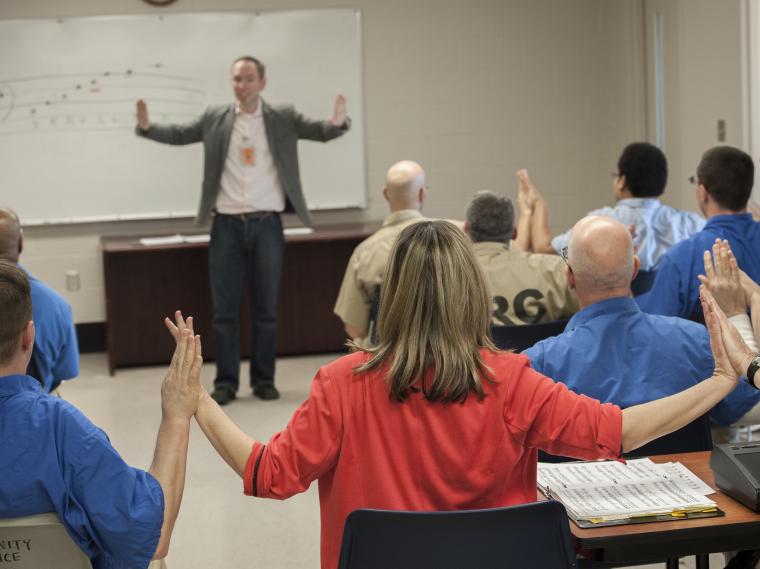PACE Program Reenvisions Music Education for the 21st Century
September 1, 2017
By Jody Kerchner

Oberlin’s legacy of innovation continues with Pedagogy, Advocacy, and Community Engagement; most courses available to college and conservatory students through September 7.
Oberlin’s music education faculty and students have long made indelible footprints in the music education profession, responding to and forging innovative directions. Beginning in the fall of 2017, that legacy of innovation will continue with the advent of a newly defined division within the conservatory dedicated to preparing students for vibrant, diverse, and meaningful careers in the continually shifting musical landscape of the 21st century. Pedagogy, Advocacy, and Community Engagement, or PACE, ensures that every Oberlin musician’s professional life begins not only with the artistic facility to forge a career of profound impact, but also the versatility of training to share that artistry with others in an unlimited variety of environments.
A hallmark of the music education profession has been its responsiveness to societal and educational needs and changes, albeit at times lagging behind the tempo in which the changes initially occur. Titles of recently published research and pedagogical trends demonstrate the profession’s critical analysis of music education and its relevance in an ever-changing world. Social justice, culturally responsive music pedagogies, LGBTQ music communities, formal and informal spaces in which music teaching and learning occurs, and curricular opportunities for students to experience what educator and author Christopher Small called “vernacular musicking” are only a few of the prominent topics that currently occupy music education discourse.
To better understand where music education is headed, perhaps it is best to start with a brief focus on where it has come from. Lowell Mason (1792-1872) is generally considered the “Father of Music Education.” Together with George James Webb, he established the Boston Academy of Music in 1833, and music as a school subject was introduced into the Boston public schools five years later. While teaching children was of primary interest to Mason, he also recognized the need to develop instructors who knew how to teach music to children effectively.
A key figure in the trajectory of the music education profession was Oberlin graduate Karl Wilson Gehrkens, who began teaching German, algebra, piano lessons, and choir in the Oberlin public schools immediately after graduating from Oberlin in 1905. Two years later, Oberlin College recruited 25-year-old Gehrkens to head its school music program. Possibly because of his formative liberal arts and music background, he carried this value for educational interdisciplinarity into his school music and collegiate teachings. In fact, Gehrkens was a driving proponent of the comprehensive musician movement in music education, in which students would learn not just how to sing or play an instrument, but about the theoretical, historical, and cultural foundations of the music they performed.
In a bold statement, he coined the slogan “Music for Every Child, Every Child for Music” advocating for public school music education as a birthright of all children. Gehrkens led Oberlin’s comprehensive music teacher training program with its first degree in school music awarded in 1923. As a teacher himself, Gehrkens responded to the need to facilitate the development of “well rounded” music educators, having witnessed the positive effects that informed music teachers have on their students.
Other Oberlin educators through the years have had profound impacts of their own:
- Former Oberlin Professor of Strings Clifford Cook is credited with exposing American string teachers to the pedagogy of Shinichi Suzuki in 1958, and with starting a Suzuki violin program for young children at Oberlin in the fall of 1963.
- Twenty years later, as a young string pedagogue, Professor Joanne Erwin traveled to Japan to study with Suzuki. Erwin followed in the footsteps of Cook and her own teacher, Paul Roland, by beginning the String Preparatory Program and teaching string pedagogy classes during her 25-year tenure at Oberlin.
- Professor Herbert Henke, recognizing the need for Dalcroze eurythmics to continue at Oberlin as a part of music teacher and performer training, earned his eurythmics license to continue the tradition at Oberlin.
- Professor Catherine Jarjisian, who studied with Edwin Gordon at Temple University, forged the pre-school Music Lab (in recent years redubbed “MusicPlay”) at Oberlin.
- Professor John Knight interviewed countless instrumental conductors in order to bring their best practices to his conducting and instrumental methods students.
- Professor Peggy Bennett, a student of Mary Helen Richards, who introduced Kodaly methodology to America, brought the SongWorks approach to her music education elementary music methods courses.
Similarly, my own mentors, Bennett Reimer and Peter Webster, have influenced my work in music education philosophy, music listening, music creativity, and music psychology. The music education faculty’s educational pedigree, past and present, has benefited students and influenced curricular and pedagogical innovation within the music education program.
WELCOME TO PACE
In the past several years, the conservatory administration and the music education faculty have once more entered into critical and sometimes deeply challenging conversations about the “next steps” for music education at the conservatory. We are motivated by current and projected trends in the music performance world, the array of skills required of performing “comprehensive musicians,” the valued place of music education within the conservatory, and societal changes in how—and which—music is taught, learned, and performed. To that end, we are proud to introduce PACE as a prelude to future opportunities in curricular and cocurricular experiences for conservatory students.
Oberlin will offer courses in the PACE curriculum beginning in the fall of 2017. Initial offerings include the following (visit the course catalog for complete details):
Fall 2017
PACE 102: Community Engagement for Musicians (taught by Dana Jessen and Louise Zeitlin)
PACE 104: String Pedagogy (Zeitlin)
PACE 220: Arts Behind Bars (Jody Kerchner)
PACE 317: Psychology of Musical Behaviors (Kerchner)
PACE 752: Gamelan Community Engagement (Jennifer Fraser)
Spring 2018
PACE 103: Community Music Engagement in Schools (Kerchner)
PACE 300: Principles of Education (Kerchner)
PACE courses 210, 211, 212, 310, 311, 312, 313, all taught by Andrea McAlister, are intended for conservatory students pursuing a piano pedagogy minor. All other courses listed above—with the exception of PACE 104—are open to students from both the college and conservatory and may be added during Oberlin’s add/drop period through September 7.
In addition, I will co-teach Arts and the Overlooked: The Activism of Access in the fall 2017 semester. This cocurricular course, taught with Associate Professor of German Language and Literatures Elizabeth Hamilton, is one of the initial offerings of Oberlin’s newly launched StudiOC program, which unites the college and conservatory through multidisciplinary, theme-based courses for first-year students. It builds on my experiences with student instructors in the Oberlin Music at Grafton program, an inmate choir I founded at a local prison. (Read more about OMAG in the 2016 Oberlin Conservatory Magazine.)
As the acronym suggests, pedagogy lies at the heart of PACE, continuing Gehrkens’ legacy at Oberlin. Teaching, at its core, however, is also an act of social justice, advocacy, and activism with the goals of promoting and supporting democratic principles such as lifelong musical access for all. To place a contemporary slant on Gehrkens’ slogan: “Music for Everyone, Everyone for Music.”
And as the music education profession embraces teaching and learning in spaces inside and outside of schools, we seek to work with undergraduate music students to ignite their interest in “music teaching” in the broadest possible sense of the term: interacting with audiences, teaching in private studios, working in chamber music ensembles, conducting, and ethnomusicological experiences. Oberlin Conservatory will continue to lead the notion of “comprehensive musicianship” that will prepare students to become informed teachers, performers, and advocates who are indelibly responsible for bringing music to whatever diverse communities they may enter.

Jody Kerchner is a professor of music education at Oberlin Conservatory and director of Pedagogy, Advocacy, and Community Engagement. To learn more about PACE, read “We Are All Teachers” in the 2017 Oberlin Conservatory Magazine.
Tags:
You may also like…
Finding the Joy with Seckou Keita
November 20, 2024
Nicknamed the “Hendrix of the kora,” Seckou Keita is today’s most influential and inspiring performer on the instrument, and is considered a leader of the newest generation of African traditional musicians, fusing traditional forms and instruments with those of other cultures.
Richard Miller Classical Voice Competition for High School Students returns in November
October 31, 2024
Oberlin Conservatory is proud to announce the return of the Richard Miller Classical Voice Competition for High School Students, a festival aimed at encouraging and supporting high school students in the pursuit of a career in classical vocal music. The festival is named in honor of Richard Miller, a member of the voice faculty at the Oberlin Conservatory of Music for more than 40 years.
Oberlin Opera Theater's Fall 2024 Production of "Cendrillon" Takes us to the Fairylands
October 30, 2024
This fall, the Oberlin Opera Theater is set to transport audiences to a world of enchantment with its production of Jules Massenet's Cendrillon. This beloved opera weaves a tale of love, magic, and transformation.


